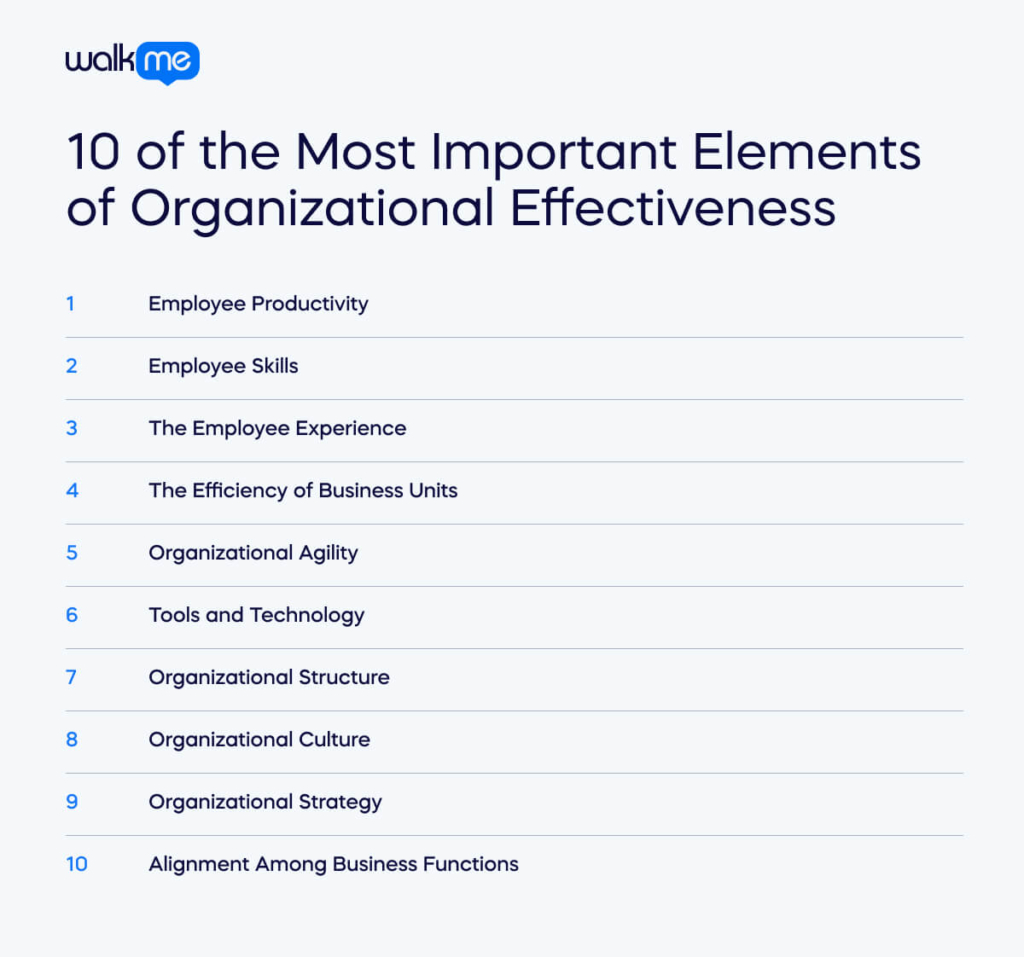What are the most important elements of organizational effectiveness?
For modern businesses, organizational effectiveness is a top concern.
After all, efficiency and effectiveness impact every area of a business, including:
- The efficiency and output of business processes
- Employee motivation and performance
- An organization’s competitive position and its bottom-line results
For reasons such as these, organizations should strive to make their business as efficient and effective as possible.
10 of the Most Important Elements of Organizational Effectiveness

Organizational effectiveness can be measured by a variety of factors, such as:
- How well it meets its stated aims and goals
- The efficiency and productivity of its individual business functions
- Whether it meets the needs of its stakeholders
- Its ability to access and utilize required resources
- A set of systems, such as leadership, communication, delivery, and performance
Regardless of how an organization defines and measures effectiveness, there are certain elements that always impact organizational effectiveness, productivity, and performance.
Here are 10 of the most important elements of organizational effectiveness:
1. Employee Productivity
Employee productivity is a major contributor to organizational effectiveness, which can impact:
- A worker’s profitability
- Their engagement and contribution to the organization
- The overall output of their business unit
There are many ways to improve employee productivity, from training to improving the work environment.
Some of these are covered below.
2. Employee Skills
Employee skills are becoming more and more important in today’s digital economy.
Here are a few reasons why:
- Proficiency affects performance
- Greater levels of expertise translate into greater software ROI
- Skilled employees are more engaged and motivated
Proficient workers, in other words, can help an organization stay productive, innovative, and competitive.
This is why digital skills training has become such a central focus for organizations undergoing digital transformation.
3. The Employee Experience
Many organizations place great emphasis on the customer experience. And for good reason: bad experiences can drive customers away in an instant.
However, the employee experience is also becoming a focal point for many businesses.
Employee experiences, after all, have an impact on employee metrics such as:
- Engagement
- Motivation
- Productivity
- Retention
Salary certainly plays a role in employee retention – but many people are willing to take pay cuts in favor of a better work environment.
Organizations that want to become more effective, therefore, should evaluate and improve their employee experience.
4. The Efficiency of Business Units
Individual business functions, of course, directly contribute to an organization’s performance.
Effective business units, therefore, should strive to be:
- Cost-effective
- Fast
- Successful
- Highly productive
There is no magic solution to enhancing efficiency for individual business units, however.
Improving each business area would require individual assessments and custom-tailored change projects.
5. Organizational Agility
Digital transformation is changing everything about the businesses operate.
Entire industries are being transformed, disrupted, or even eliminated, making adaptability a key survival trait.
In such a volatile business landscape, agility means that organizations can:
- Change efficiently and effectively
- Be more responsive and flexible
- Adopt new tools and processes quickly and efficiently
- Stay competitive
Becoming agile may require new mindsets, cultural changes, and other deep organizational shifts.
These changes can be costly, but the results are well worth the investment.
6. Tools and Technology
The right digital technology can help an organization keep up, get ahead, and stay ahead.
With an appropriate digital adoption strategy, organizations can:
- Create a streamlined digital workflow
- Improve employee performance
- Generate performance gains across an organization
It is also worth noting that merely deploying digital technology is not enough … organizations must ensure that employees are well-trained and proficient.
Otherwise, employee productivity will stagnate and businesses will be unable to capitalize on the full value of their software investments.
7. Organizational Structure
Organizational structure also affects organizational effectiveness and can impact:
- Employee metrics such as engagement, motivation, and productivity
- Leadership and management effectiveness
- Business processes
- Organizational culture
There is no “right” structure for a business – some are hierarchical, some are flat, and some have other structures.
However, certain characteristics are more suited to the digital economy.
Organizational structures that enable innovation, change, and employee learning, for instance, will fare better than structures that are slower and less adaptable.
8. Organizational Culture
Another factor that impacts organizational effectiveness is organizational culture.
Just as there is no “right” organizational structure, there is no “right” organizational culture.
However, certain cultural traits will be more likely to enhance an organization’s overall effectiveness.
Organizations that want to improve their culture should consider cultivating cultures that are:
- Innovative
- Pro-learning
- Digital-friendly
- Open to change
Cultural change can certainly bring benefits to a workplace.
But since it can also be very disruptive, business leaders should weigh the benefits and drawbacks carefully beforehand.
9. Organizational Strategy
An organization’s strategy is another factor that affects business performance.
As mentioned, the digital revolution is well underway, which means that certain strategic imperatives more valuable than others.
In the digital era, effective strategies should be:
- Relevant to the current business environment
- Forward-thinking
- Digital-first
- Customer-centered
In other words, the right strategy should consider a business’s place in the context of its industry, as well as the evolving digital landscape.
10. Alignment Among Business Functions
Business functions that are disconnected from one another produce waste, inefficiencies, and poor communication.
Effective organizations will have a greater alignment between:
- Separate business units
- Business functions and organizational strategy
- Organizational behavior and an organization’s values
A well-aligned organization will suffer from fewer delays, less internal friction, and fewer miscommunications.
Greater alignment will integrate the big-picture strategy with frontline operations, producing better results in a shorter time frame.

